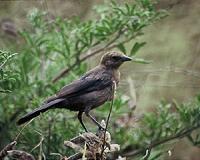| . |  |
. |
Madrid, Spain (SPX) Mar 09, 2011 A research study in which the Universidad Carlos III de Madrid (UC3M) is participating has found evidence that suggests that the key to locomotion in snails stems from the animal's complex muscle movements, and not from its mucus, as had been previously thought. This finding could open the door to the construction of robots which could imitate this form of propulsion. The main aim of this study, carried out in collaboration with the University of California at San Diego (UCSD) and Stanford University (both in the US) is to characterize some aspects of gastropod (snails and slugs) locomotion to basically respond to one question: To what extent do they depend on the physical properties of their mucus to propel themselves forward? This question is fundamental when applying the studied mechanism to the construction of biomimetic robots. "The aim is for the robot to be able to propel itself in any fluid mucus without having to carry its own reserve of mucus along," explained one of the authors of the research study, Javier Rodriguez, Professor at the UC3M Department of Thermal and Fluids Engineering. "Bear in mind," he stated, "that snail mucus has a very particular behaviour because it is a specific type of fluid with complex physical characteristics called non-Newtonian fluid." Until now, it was known that snails and slugs move by propagating their body in a series of muscular wave motions to advance from their tail to their head, but the importance of their mucus in this process was not known. The conclusion obtained by these scientists is that this fluid's properties are not essential for propulsion. "Without a doubt, it could have other uses, such as climbing walls, moving upside down, or preserving moisture in the body when on a dry surface, but if we want to construct a robot that emulates a snail, the latter could move over fluid mucus with ordinary properties" pointed out Professor Rodriguez, who has recently published an article on this matter, together with his colleagues from the North American universities, in the scientific review, Journal of Experimental Biology. To carry out this study, the researchers have characterized the propagation of these muscular waves which occur along the body of gastropods. For this purpose, they place the snails and slugs so that they move on transparent surfaces, illuminating their undersides in different ways so as to record images through digital cameras, subsequently analyzing this data by computer. "The ways to illuminate the body vary depending on what is being measured," stated Maria Vazquez, research fellow from the UC3M Fluid Mechanics Group where she has collaborated in experiments carried out in Spain and in the US. "For example", she explained further, "to measure the speed of the wave, we placed a light on the underneath part of the snail, while to measure the vertical deformation of the body we used a low power flat laser (so as not to harm the animal) projected at a given angle." Together, all of these measures have allowed the 3D reconstruction of the snail's underside during propulsion.
Very diverse applications "What also happens," Professor Rodriguez pointed out, "is that it is difficult to move over glue without exerting quite a bit of force while dragging fluid along." Snails, after millions of years of evolution, have succeeded in being able to move on a highly adhesive This type of research can help in the design of biomimetic robots that carry out functions which conventional devices cannot do. Some Japanese researchers, for example, propose using the snail propulsion mechanism to move an endoscope though a human body (the trachea, intestines, etc), taking advantage of the mucus film that usually covers these ducts. "This mechanism," Javier Rodriguez remarked, "generates a smooth distribution of force instead of supporting itself in concrete points, which would reduce the irritation caused by the movement of an endoscope, in this case." At the moment, the results published by the UC3M, UCSD and Stanford scientists only deal with the experimental part of study carried out, although they are working on a second article that includes a simple theoretical model which explains these animals' movement. The preliminary results were presented last November at the Annual Conference of The American Physical Society. In addition, these researchers are interested in extending their analysis to situations in which the animal moves up slopes of varying angles.
Share This Article With Planet Earth
Related Links Universidad Carlos III de Madrid (UC3M) Darwin Today At TerraDaily.com
 Fossil Bird Study Describes Ripple Effect Of Extinction In Animal Kingdom
Fossil Bird Study Describes Ripple Effect Of Extinction In Animal KingdomGainesville FL (SPX) Mar 09, 2011 A University of Florida study demonstrates extinction's ripple effect through the animal kingdom, including how the demise of large mammals 20,000 years ago led to the disappearance of one species of cowbird. The study shows the trickle-down effect the loss of large mammals has on other species, and researchers say it is a lesson from the past that should be remembered when making conserva ... read more |
|
| The content herein, unless otherwise known to be public domain, are Copyright 1995-2010 - SpaceDaily. AFP and UPI Wire Stories are copyright Agence France-Presse and United Press International. ESA Portal Reports are copyright European Space Agency. All NASA sourced material is public domain. Additional copyrights may apply in whole or part to other bona fide parties. Advertising does not imply endorsement,agreement or approval of any opinions, statements or information provided by SpaceDaily on any Web page published or hosted by SpaceDaily. Privacy Statement |